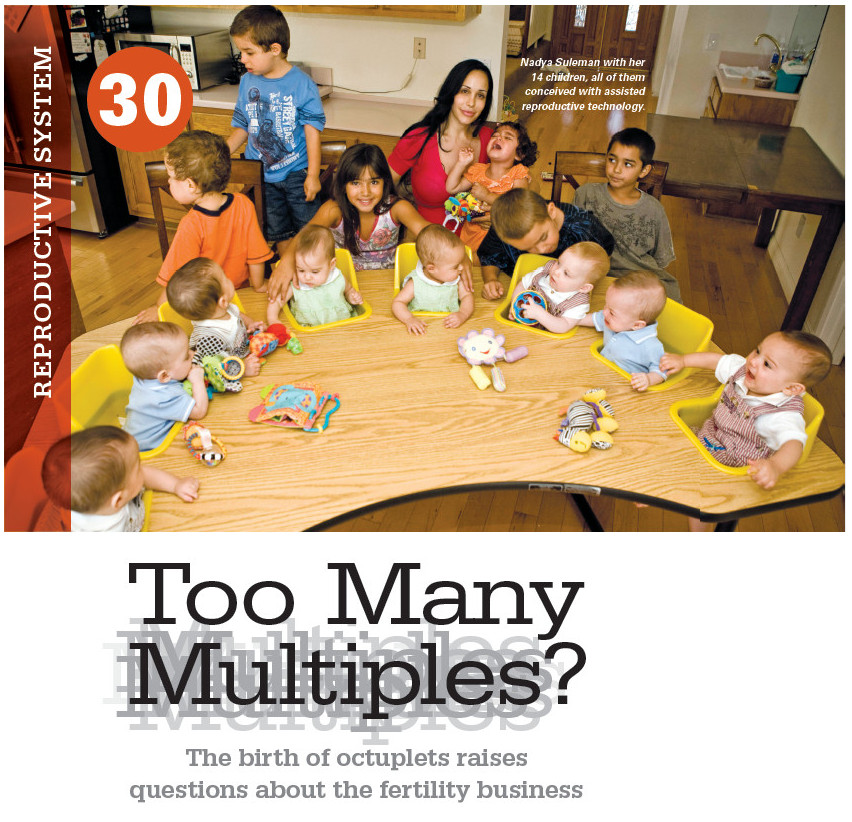664

665
Scientists estimate that the incidence of natural triplets is 1 in 6,000 to 8,000 births—of quadruplets, 1 in 500,000 births.
DRIVING QUESTIONS
- What is the anatomy of the male and female reproductive tracts?
- What hormones are involved in reproduction, and how do they work?
- What are the different types of assisted reproduction, and how do they work?
In-Class Activity
Click here to access Lecture ppt specifically designed for chapter 30.
Click here to access Clicker Questions specifically designed for chapter 30.
 HE LIVE BIRTH OF OCTUPLETS IS AN EXTREMELY RARE EVENT, HAVING occurred only once in recorded U.S. history before the year 2000. So the arrival of a second set in a California hospital in January 2009 was greeted with fanfare. Headlines read “Octuplets Stun Doctors” and “Eight Babies!”
HE LIVE BIRTH OF OCTUPLETS IS AN EXTREMELY RARE EVENT, HAVING occurred only once in recorded U.S. history before the year 2000. So the arrival of a second set in a California hospital in January 2009 was greeted with fanfare. Headlines read “Octuplets Stun Doctors” and “Eight Babies!”
But days after news of the miracle multiple birth spread worldwide, the public reception turned sour when it came to light that the 33-year-old mother, Nadya Suleman, already had six children all under the age of 7 who were, like the octuplets, conceived using a form of assisted reproductive technology called in vitro fertilization.
Even more disturbing to some, Suleman was an unemployed single mother on welfare. The public outcry was fierce. How could she support her children? Was she psychologically disturbed? And why had her doctor agreed to give her fertility treatments when she already had six children?
The case cast a spotlight on the business of fertility treatment: in the United States fertility clinics are largely unregulated. Although the American Society of Reproductive Medicine (ASRM) issues guidelines on how doctors should administer fertility services, in most states there are no laws regulating what doctors can and cannot do in this regard. Though critics called Suleman’s doctor irresponsible, he had not violated any laws.
Infertility treatment wouldn’t be nearly as controversial if it didn’t increase the odds that a woman will conceive more than one child during the treatment. “Multiples,” as these babies are called, are often born prematurely. Consequently, they are underweight and have underdeveloped organs, and so are at risk for birth defects such as cerebral palsy and infant respiratory distress syndrome. Carrying multiples also increases the risk that the mother will develop dangerously high blood pressure, diabetes, vitamin deficiencies, or one or another of several other medical conditions during her pregnancy that may affect her health or that of her unborn children. Even women who have twins have a higher risk of medical complications during pregnancy, and their babies are at a higher risk of premature birth than singletons. Suleman’s eight children are the only surviving set of octuplets ever.
666
Multiple births without fertility treatment are extremely rare. Scientists estimate that the incidence of natural triplets is 1 in 6,000 to 8,000 births—of quadruplets, 1 in 500,000 births. The incidence of higher-order multiple births is even rarer. But because the use of assisted reproductive technologies has skyrocketed, so, too, have the number of multiple births. The number of triplet births rose 400% between 1980 and 1998, according to statistics compiled by the Centers for Disease Control and Prevention. The medical complications associated with such pregnancies place a large burden on the health care system.
Although there have been efforts to improve assisted reproductive technology and therefore reduce the likelihood of multiple births, extreme cases such as Suleman’s have drawn lawmakers to the scene. Many states are considering legislation that would place restrictions on fertility doctors. Working from another perspective, some groups are fighting for legislation that would require health insurance providers to pay for fertility treatments. Because many patients pay out of pocket, patients with limited financial resources can, because of their circumstances, pressure doctors to be aggressive with treatment, despite the health risks associated with carrying multiples. The goal of this legislation is to make assisted reproduction safer for everyone, not just for those who can afford it.